YAMAHA SUV 1200 2001 Manual Online
Manufacturer: YAMAHA, Model Year: 2001, Model line: SUV 1200, Model: YAMAHA SUV 1200 2001Pages: 135, PDF Size: 21.67 MB
Page 81 of 135
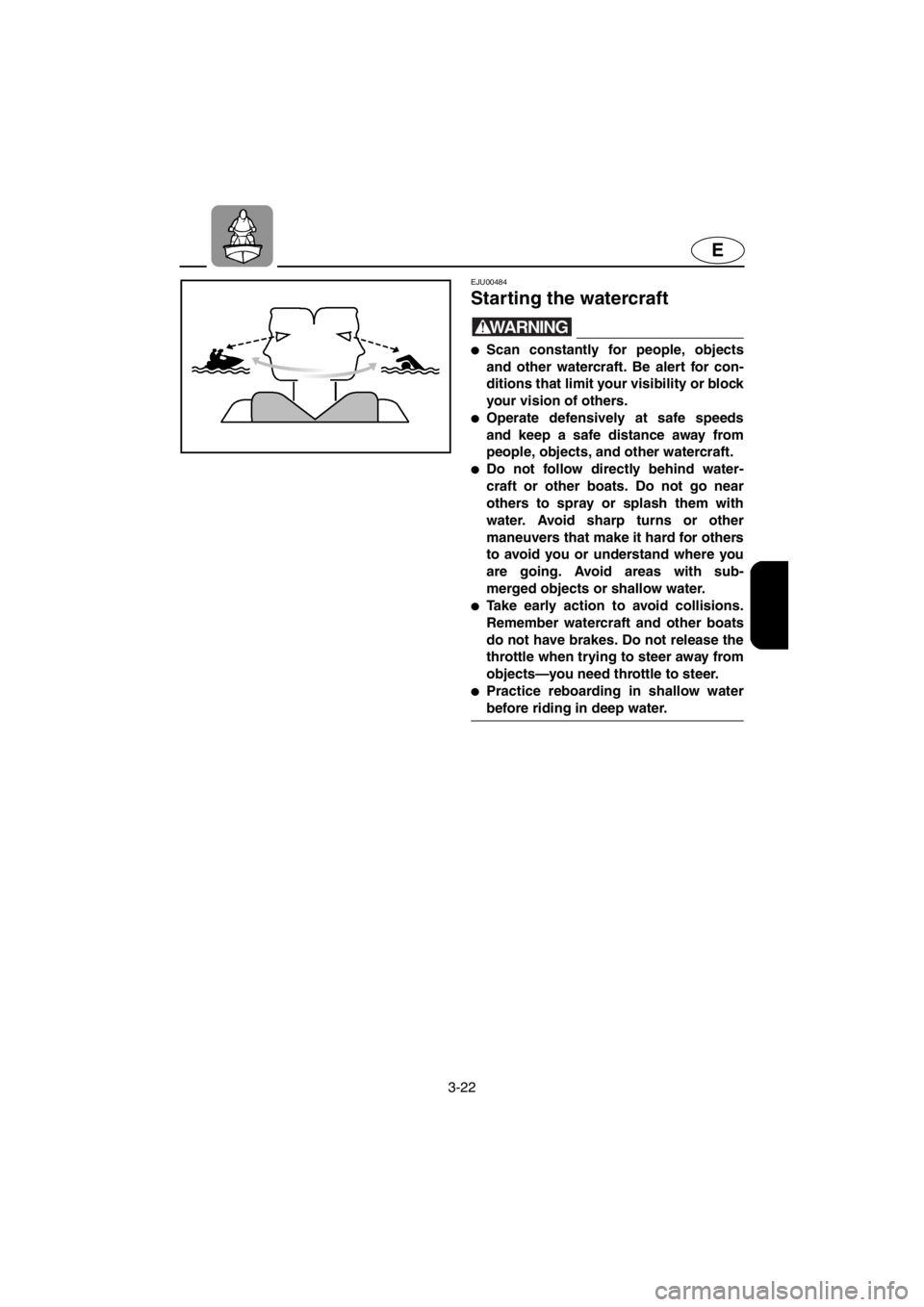
3-22
E
EJU00484
Starting the watercraft
WARNING
●Scan constantly for people, objects
and other watercraft. Be alert for con-
ditions that limit your visibility or block
your vision of others.
●Operate defensively at safe speeds
and keep a safe distance away from
people, objects, and other watercraft.
●Do not follow directly behind water-
craft or other boats. Do not go near
others to spray or splash them with
water. Avoid sharp turns or other
maneuvers that make it hard for others
to avoid you or understand where you
are going. Avoid areas with sub-
merged objects or shallow water.
●Take early action to avoid collisions.
Remember watercraft and other boats
do not have brakes. Do not release the
throttle when trying to steer away from
objects—you need throttle to steer.
●Practice reboarding in shallow water
before riding in deep water.
E_GU5-71-3.fm Page 22 Thursday, July 13, 2000 7:52 PM
Page 82 of 135
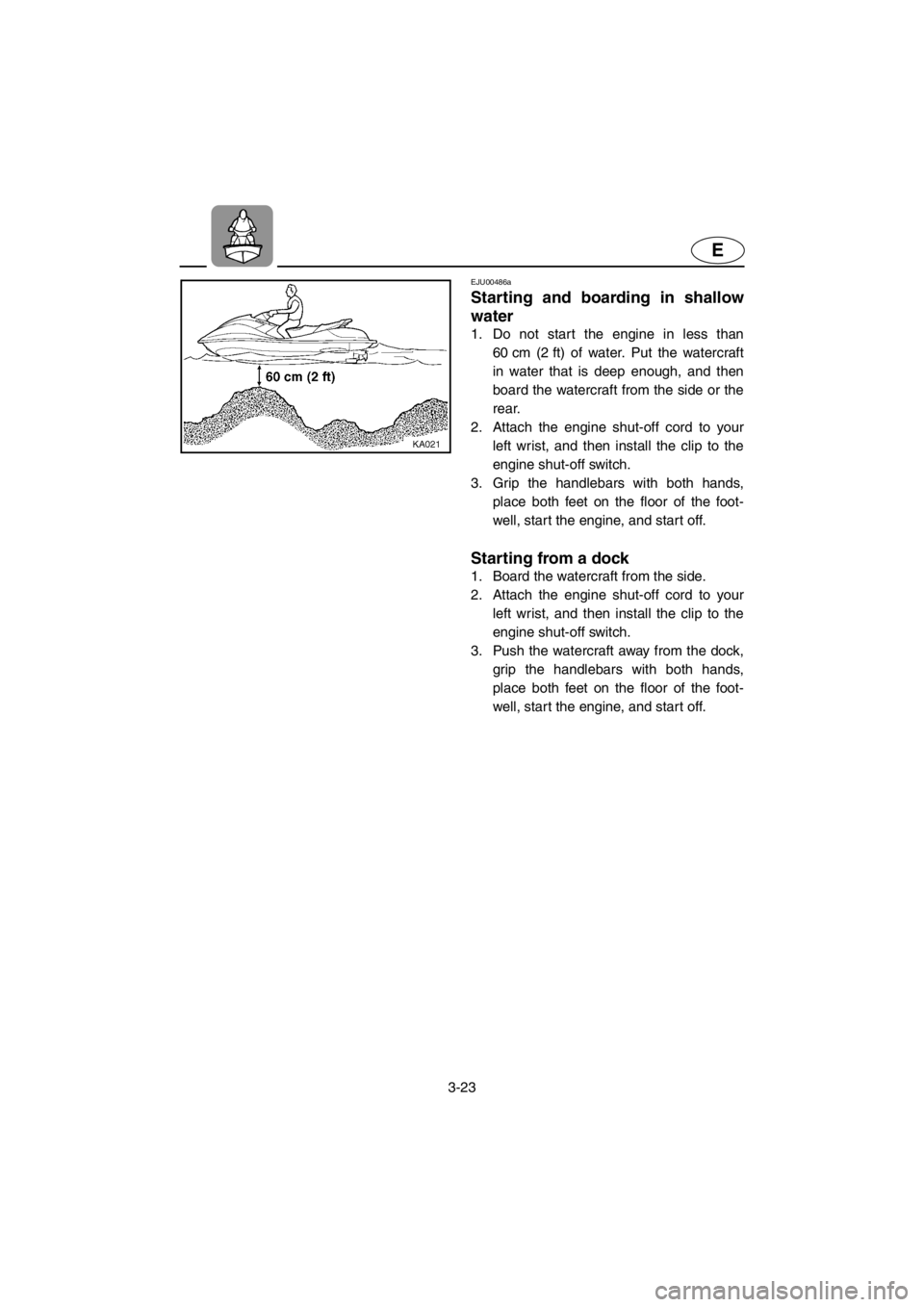
3-23
E
EJU00486a
Starting and boarding in shallow
water
1. Do not start the engine in less than
60 cm (2 ft) of water. Put the watercraft
in water that is deep enough, and then
board the watercraft from the side or the
rear.
2. Attach the engine shut-off cord to your
left wrist, and then install the clip to the
engine shut-off switch.
3. Grip the handlebars with both hands,
place both feet on the floor of the foot-
well, start the engine, and start off.
Starting from a dock
1. Board the watercraft from the side.
2. Attach the engine shut-off cord to your
left wrist, and then install the clip to the
engine shut-off switch.
3. Push the watercraft away from the dock,
grip the handlebars with both hands,
place both feet on the floor of the foot-
well, start the engine, and start off.
E_GU5-71-3.fm Page 23 Thursday, July 13, 2000 7:52 PM
Page 83 of 135
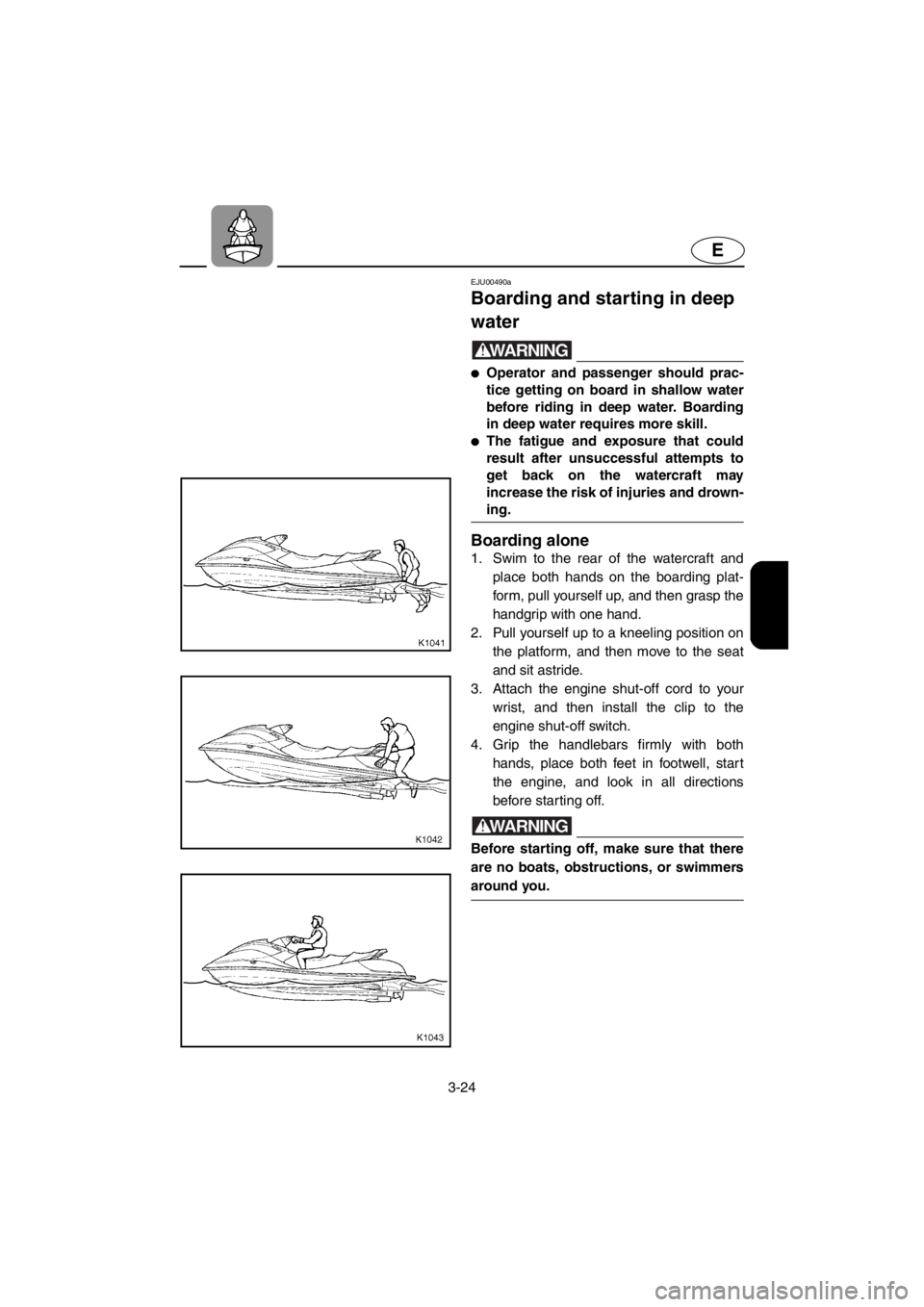
3-24
E
EJU00490a
Boarding and starting in deep
water
WARNING
●Operator and passenger should prac-
tice getting on board in shallow water
before riding in deep water. Boarding
in deep water requires more skill.
●The fatigue and exposure that could
result after unsuccessful attempts to
get back on the watercraft may
increase the risk of injuries and drown-
ing.
Boarding alone
1. Swim to the rear of the watercraft and
place both hands on the boarding plat-
form, pull yourself up, and then grasp the
handgrip with one hand.
2. Pull yourself up to a kneeling position on
the platform, and then move to the seat
and sit astride.
3. Attach the engine shut-off cord to your
wrist, and then install the clip to the
engine shut-off switch.
4. Grip the handlebars firmly with both
hands, place both feet in footwell, start
the engine, and look in all directions
before starting off.
WARNING
Before starting off, make sure that there
are no boats, obstructions, or swimmers
around you.
E_GU5-71-3.fm Page 24 Thursday, July 13, 2000 7:52 PM
Page 84 of 135
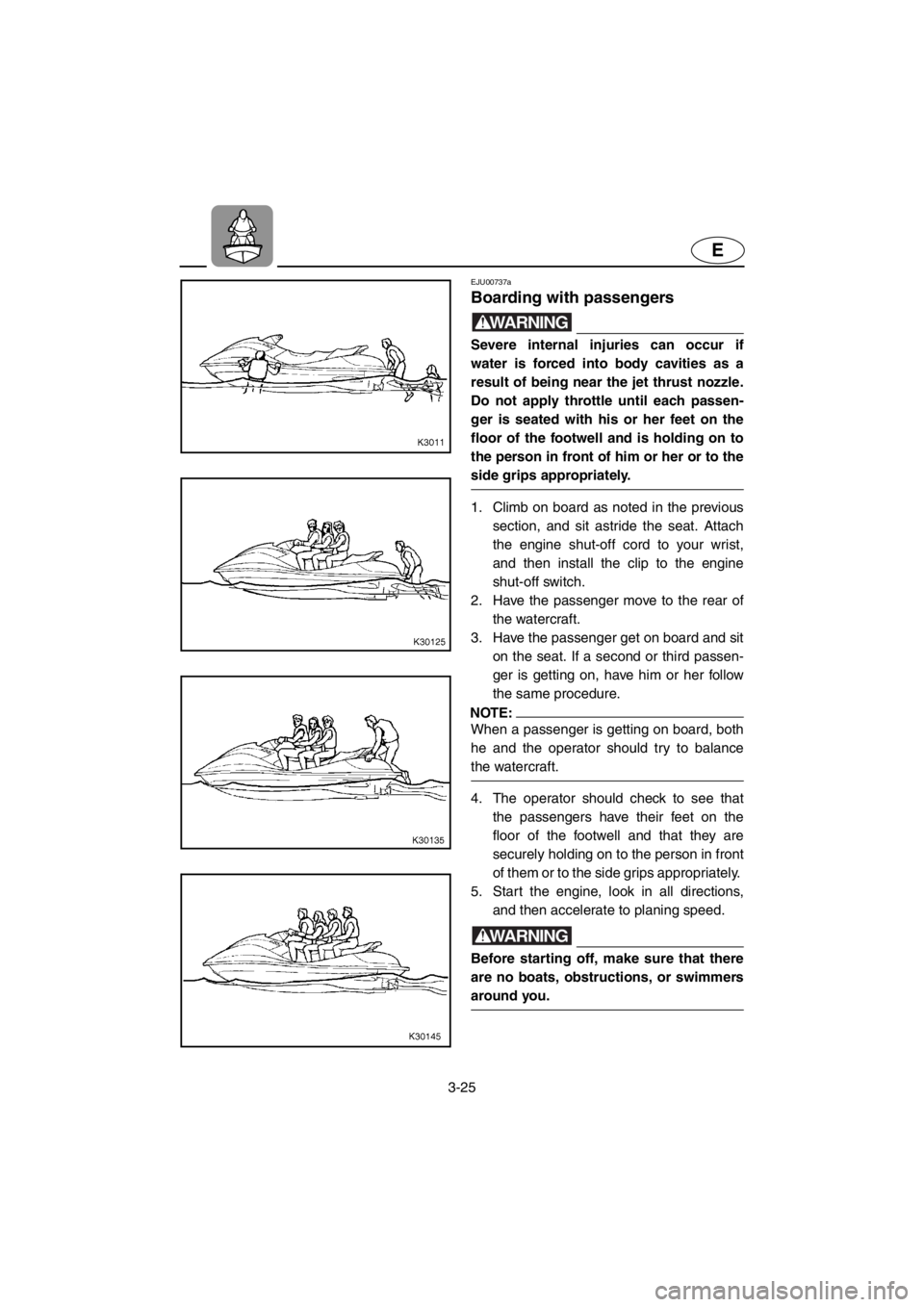
3-25
E
EJU00737a
Boarding with passengers
WARNING
Severe internal injuries can occur if
water is forced into body cavities as a
result of being near the jet thrust nozzle.
Do not apply throttle until each passen-
ger is seated with his or her feet on the
floor of the footwell and is holding on to
the person in front of him or her or to the
side grips appropriately.
1. Climb on board as noted in the previous
section, and sit astride the seat. Attach
the engine shut-off cord to your wrist,
and then install the clip to the engine
shut-off switch.
2. Have the passenger move to the rear of
the watercraft.
3. Have the passenger get on board and sit
on the seat. If a second or third passen-
ger is getting on, have him or her follow
the same procedure.
NOTE:
When a passenger is getting on board, both
he and the operator should try to balance
the watercraft.
4. The operator should check to see that
the passengers have their feet on the
floor of the footwell and that they are
securely holding on to the person in front
of them or to the side grips appropriately.
5. Start the engine, look in all directions,
and then accelerate to planing speed.
WARNING
Before starting off, make sure that there
are no boats, obstructions, or swimmers
around you.
E_GU5-71-3.fm Page 25 Thursday, July 13, 2000 7:52 PM
Page 85 of 135

3-26
E
NOTE:
The heavier the total weight of the operator
and passengers, the more difficult it will be
to balance the watercraft. Do not operate the
watercraft when the total weight exceeds
300 kg (622 lb) including any cargo.
EJU00677a
Capsized watercraft
If the watercraft capsizes, follow the pro-
cedures below carefully to prevent damage
or injury.
WARNING
IMPROPER UPRIGHTING CAN CAUSE
INJURY:
●Shut engine off, and be sure engine
shut-off cord is removed from the
engine shut-off switch.
●Do not put hand in intake grate if
engine is running.
●Watch so you are not hit by the water-
craft as it comes over.
E_GU5-71-3.fm Page 26 Thursday, July 13, 2000 7:52 PM
Page 86 of 135
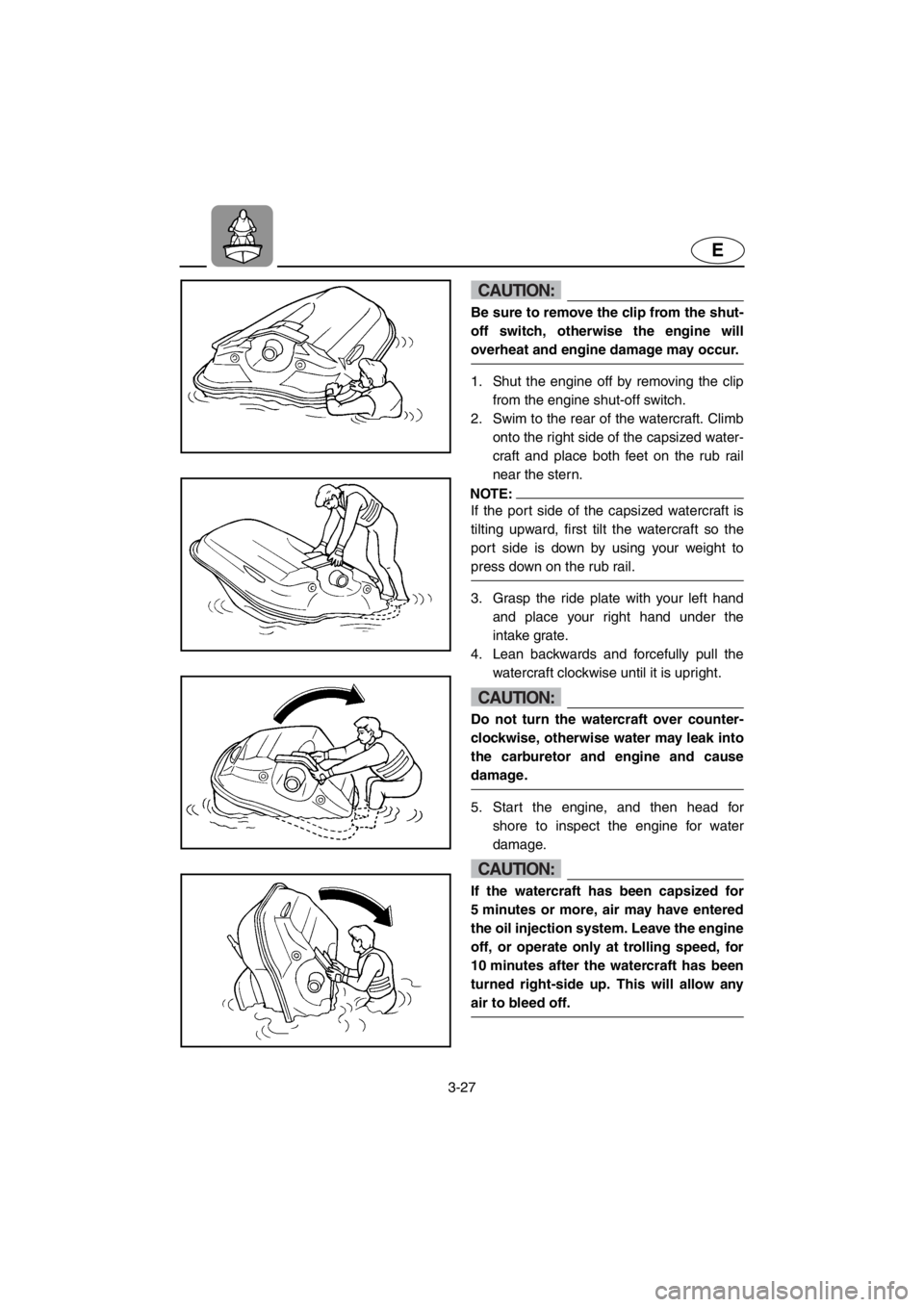
3-27
E
CAUTION:
Be sure to remove the clip from the shut-
off switch, otherwise the engine will
overheat and engine damage may occur.
1. Shut the engine off by removing the clip
from the engine shut-off switch.
2. Swim to the rear of the watercraft. Climb
onto the right side of the capsized water-
craft and place both feet on the rub rail
near the stern.
NOTE:
If the port side of the capsized watercraft is
tilting upward, first tilt the watercraft so the
port side is down by using your weight to
press down on the rub rail.
3. Grasp the ride plate with your left hand
and place your right hand under the
intake grate.
4. Lean backwards and forcefully pull the
watercraft clockwise until it is upright.
CAUTION:
Do not turn the watercraft over counter-
clockwise, otherwise water may leak into
the carburetor and engine and cause
damage.
5. Start the engine, and then head for
shore to inspect the engine for water
damage.
CAUTION:
If the watercraft has been capsized for
5 minutes or more, air may have entered
the oil injection system. Leave the engine
off, or operate only at trolling speed, for
10 minutes after the watercraft has been
turned right-side up. This will allow any
air to bleed off.
E_GU5-71-3.fm Page 27 Thursday, July 13, 2000 7:52 PM
Page 87 of 135
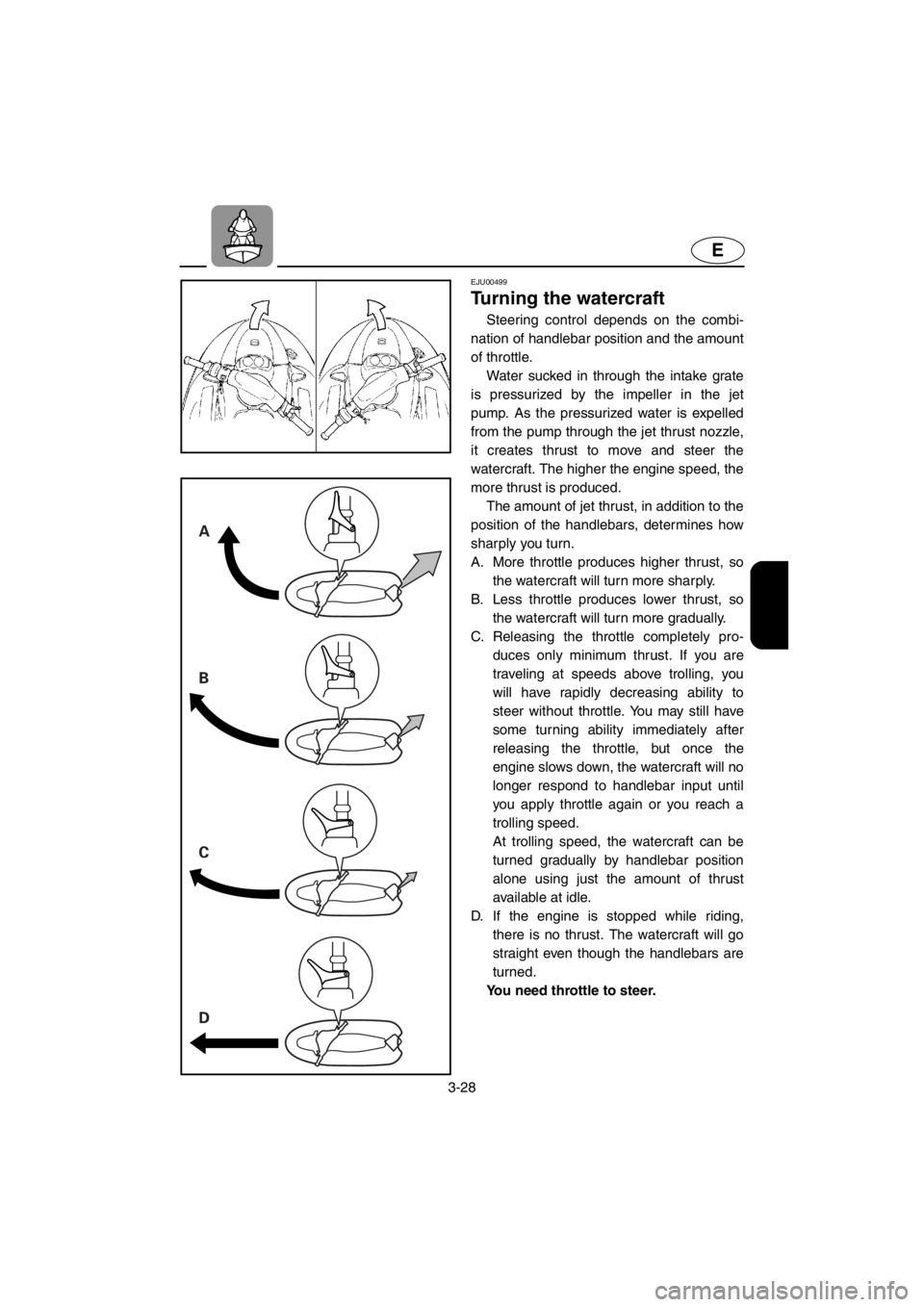
3-28
E
A
B
C
D
EJU00499
Turning the watercraft
Steering control depends on the combi-
nation of handlebar position and the amount
of throttle.
Water sucked in through the intake grate
is pressurized by the impeller in the jet
pump. As the pressurized water is expelled
from the pump through the jet thrust nozzle,
it creates thrust to move and steer the
watercraft. The higher the engine speed, the
more thrust is produced.
The amount of jet thrust, in addition to the
position of the handlebars, determines how
sharply you turn.
A. More throttle produces higher thrust, so
the watercraft will turn more sharply.
B. Less throttle produces lower thrust, so
the watercraft will turn more gradually.
C. Releasing the throttle completely pro-
duces only minimum thrust. If you are
traveling at speeds above trolling, you
will have rapidly decreasing ability to
steer without throttle. You may still have
some turning ability immediately after
releasing the throttle, but once the
engine slows down, the watercraft will no
longer respond to handlebar input until
you apply throttle again or you reach a
trolling speed.
At trolling speed, the watercraft can be
turned gradually by handlebar position
alone using just the amount of thrust
available at idle.
D. If the engine is stopped while riding,
there is no thrust. The watercraft will go
straight even though the handlebars are
turned.
You need throttle to steer.
E_GU5-71-3.fm Page 28 Thursday, July 13, 2000 7:52 PM
Page 88 of 135

3-29
E
WARNING
●Do not release the throttle when trying
to steer away from objects—you need
throttle to steer. A collision could
result in severe injury or death.
●When operating at higher speeds,
make gradual turns or slow down
before turning. Sharp high-speed turns
may cause the watercraft to slide side-
ways or spin, throwing the operator
and passengers overboard which
could cause an injury.
E_GU5-71-3.fm Page 29 Thursday, July 13, 2000 7:52 PM
Page 89 of 135
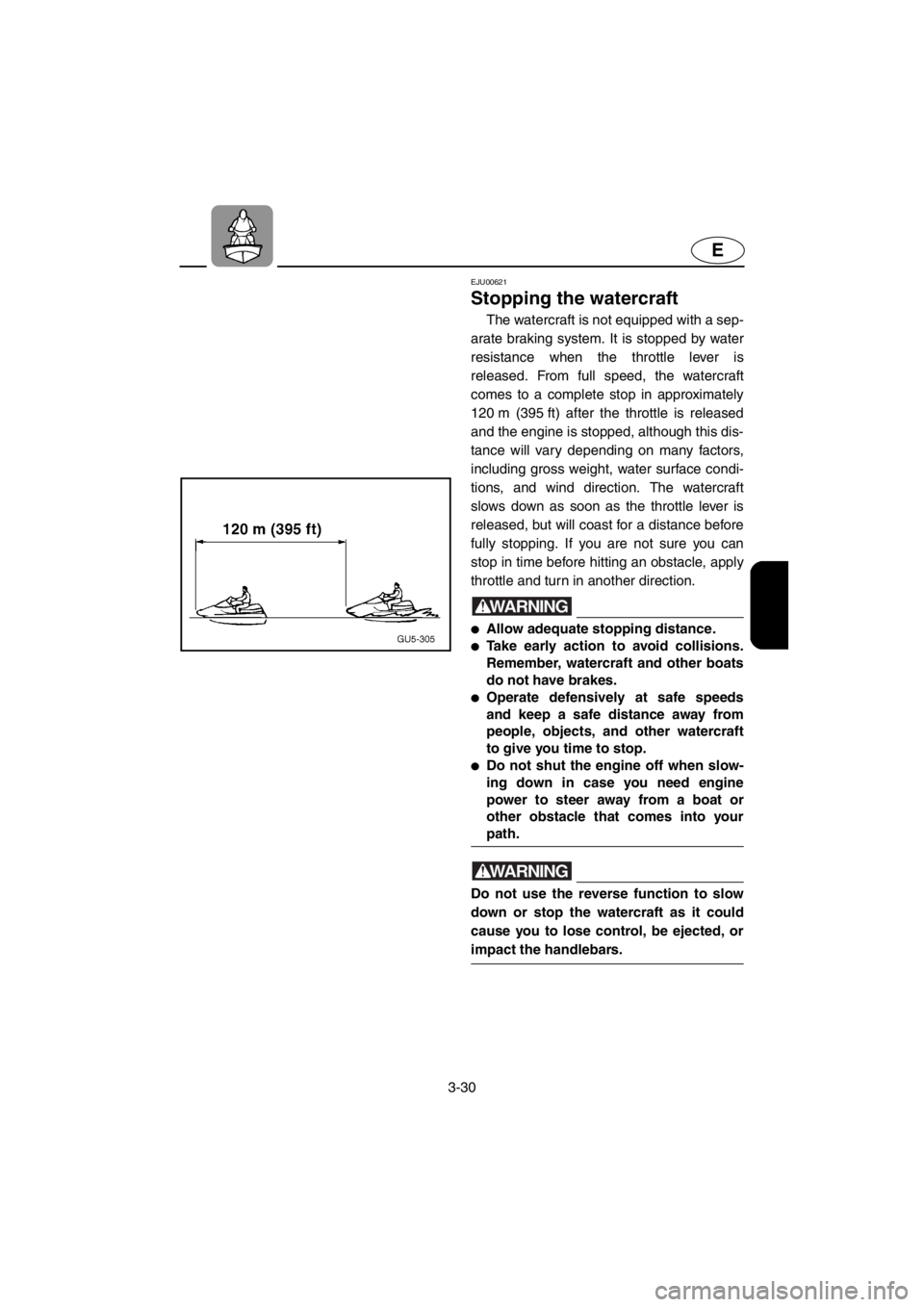
3-30
E
EJU00621
Stopping the watercraft
The watercraft is not equipped with a sep-
arate braking system. It is stopped by water
resistance when the throttle lever is
released. From full speed, the watercraft
comes to a complete stop in approximately
120 m (395 ft) after the throttle is released
and the engine is stopped, although this dis-
tance will vary depending on many factors,
including gross weight, water surface condi-
tions, and wind direction. The watercraft
slows down as soon as the throttle lever is
released, but will coast for a distance before
fully stopping. If you are not sure you can
stop in time before hitting an obstacle, apply
throttle and turn in another direction.
WARNING
●Allow adequate stopping distance.
●Take early action to avoid collisions.
Remember, watercraft and other boats
do not have brakes.
●Operate defensively at safe speeds
and keep a safe distance away from
people, objects, and other watercraft
to give you time to stop.
●Do not shut the engine off when slow-
ing down in case you need engine
power to steer away from a boat or
other obstacle that comes into your
path.
WARNING
Do not use the reverse function to slow
down or stop the watercraft as it could
cause you to lose control, be ejected, or
impact the handlebars.
E_GU5-71-3.fm Page 30 Thursday, July 13, 2000 7:52 PM
Page 90 of 135

3-31
E
EJU00635
Beaching the watercraft
1. Make sure no obstructions, boats or
swimmers are near the beach. Release
the throttle lever about 120 m (395 ft)
before you reach the intended beaching
area.
2. Approach the beach slowly and stop the
engine before reaching land. Remem-
ber: you need throttle to steer.
3. Get off the watercraft and pull it up on
the beach.
CAUTION:
Small pebbles, sand, seaweed, and other
debris can be pulled into the jet intake
and impair or damage the impeller.
Always stop the engine and get off
before beaching the watercraft.
EJU00505
Docking the watercraft
1. Make sure that no obstructions, boats or
swimmers are close to the watercraft.
Reduce speed about 120 m (395 ft)
away from the dock.
2. Slowly approach the dock and stop the
engine just before coming alongside it.
E_GU5-71-3.fm Page 31 Thursday, July 13, 2000 7:52 PM